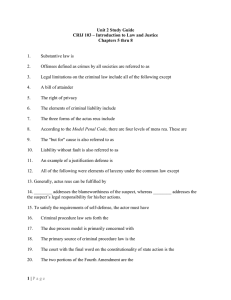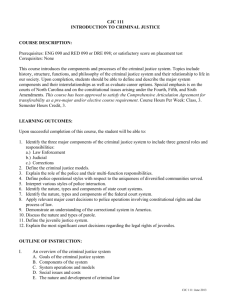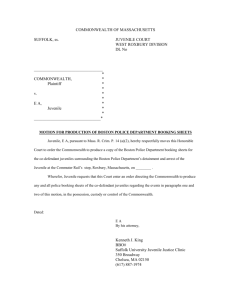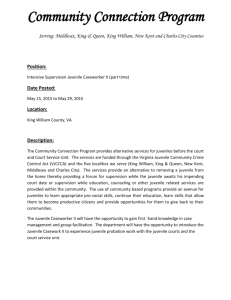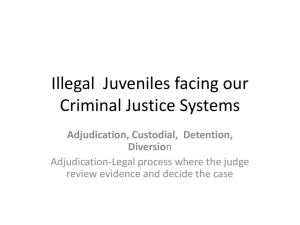The Juvenile Liaison Scheme by Sergeant Seilest Bradshaw
advertisement
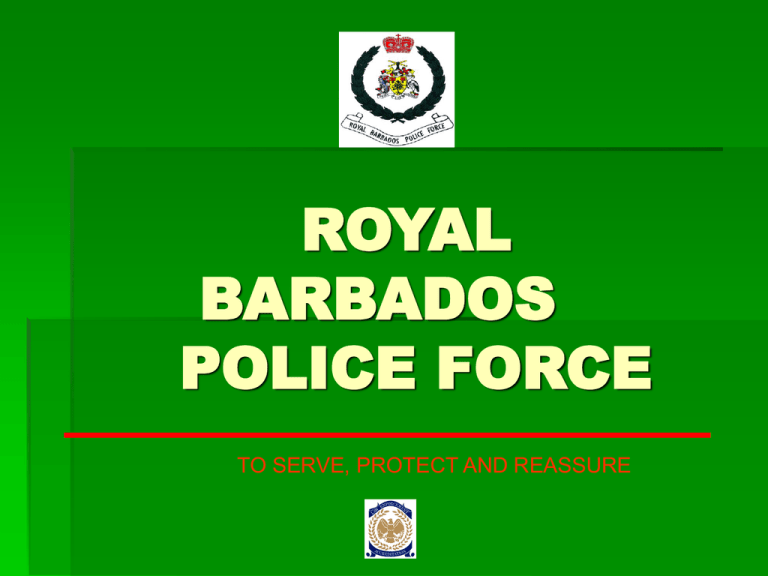
ROYAL
BARBADOS
POLICE FORCE
TO SERVE, PROTECT AND REASSURE
A PRIMARY DIVERSIONARY
PROGRAMME
Presented By:
SGT. SEILEST BRADSHAW
Juvenile Liaison Officer
BACKGROUND
THE R.B.P.F. ESTABLISHED THE J.L.S IN
1983
CONSULTATION WITH SOCIAL AGENCIES.
BASED ON STATISTICAL DATA SHOWING
ALARMING INCREASES IN CRIMES
COMMITTED BY JUVENILES.
PERSUASIONAL FACT:
MANY OF THE ADULTS INVOLVED IN CRIME HAD A HISTORY
OF CRIMINAL CONDUCT DURING ADOLESCENCE.
STRUCTURE
JUVENILE LIAISON COMMITTEE
JUVENILE LIAISON OFFICE
J. L. S. COMMITTEE
CHAIRMAN {Commissioner or Nominee}
LIAISON OFFICERS
WELFARE DEPARTMENT
CHILD CARE BOARD
PROBATION DEPARTMENT
MINISTRY OF EDUCATION
ATTORNEY GENERAL’S OFFICE
CLERGY
JUVENILE LIAISON
OFFICE
Head of Department
(Sergeant S. Bradshaw)
Three Constables
Two males
One female
OBJECTIVES
To reduce juvenile delinquency.
To divert juvenile offenders from the rigorous and
traumatic experiences of the Criminal Justice
System.
To counsel juveniles, as well as their parents, who
are considered to be at risk of becoming involved
in criminal activity.
To provide voluntary supervision of Juveniles.
IDENTIFICATION OF
JUVENILE
WHO CAN REFER ?
POLICE OFFICERS
BUSINESS COMMUNITY
SOCIAL AGENCIES
SCHOOL ADMINISTRATORS
PARENTS
CONCERNED CITIZENS
WHO IS REFERRED
(Juveniles 11- 16 years)
Juveniles who exhibit behavioural problem
Juveniles who have committed minor
offences
CRITERIA:
Provided that the aggrieved party has no
objections and is in agreement.
Where it is a first offence
The Juvenile in the presence of the parent admits
his/her wrongdoing and is willing to be a part of
the programme.
Parents agree to have child/ward admitted
ENGAGING THE CLIENT
On entering the scheme a juvenile is
counselled and supervised for a period of
six months.
Counselling sessions are between thirty
forty-five minutes a week for the first four
weeks. Assessment/ Plan Intervention
ENGAGEMENT CONT’D
If the juvenile shows signs of improvement, visits may be
adjusted to every two or three weeks as determined by the
counsellor.
Home and school visits forms part of the ongoing
assessment.
At the end of the six months the J.L.S Management
Committee makes a determination whether to administer
the Police Caution or extend the counselling period
POLICE CAUTION
Where a juvenile commits an offence
subject to trial by a Magistrate.
The police may take the decision to
caution the offender rather than
prosecute.
First Offence, Circumstances
SUCCESS OF THE
SCHEME
TRACER STUDY 1998
RANDOM SAMPLE { 1984 1987 1991}
20% OF PARTICIPANTS OF EACH YEAR
Criminal Records Office (C.R.O.) of the
R.B.P.F. was used for verification of
subsequent convictions.
Study
PARTICIPANTS
1984
1987
1991
Total
Males
Females
56% referred for
criminal offences
31
24
24
79
16% referred for
status offences
51
28
28% for behavioural
problems
ADULT CONVICTION
# of
Convictions
# of Persons
Percentage
0
63
79.7 %
1-3
12
15 .2%
4-7
3
3.8 %
12 or more
1
1.3 %
TOTAL
79
100 %
ELAPSED TIME
5
7
3
Clients 1-3 yrs
Clients 4-7 yrs
Clients 8-11 yrs
To February 1997
1984 22.6 %
1987 29 %
1991 7 %
IMPLICATIONS
Majority of offenders committed they first crime
four (4) years after release from the programme.
Trends indicate that the further removed the clients
are from the programme the more likely they are to
commit criminal acts.
In Britain (Home Office Circular 14/1994) there was
a 33% rate of subsequent convictions for similar
Schemes.
COORDINATED ACTIVITIES
• AUXILLARY STAFF - Volunteers
• SUPPORT GROUP - Parents
•PROGRAMMES
•CHRISTMAS
•SCHOOL OUTREACH
•SUMMER
•INDEPENDENCE
•GROWTH ORIENTED
REMARKS
Motto:
LISTENING,
UNDERSTANDING
AND
SHARING
